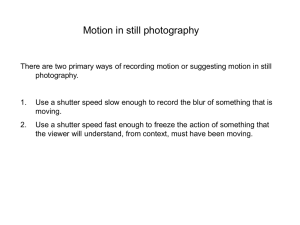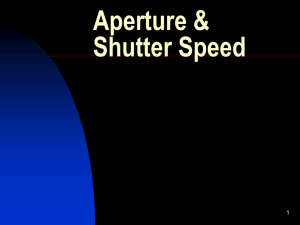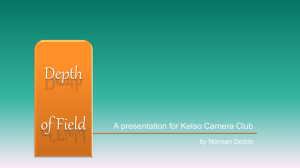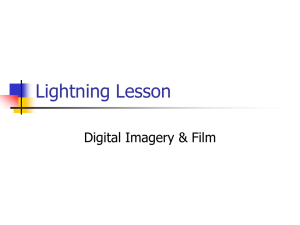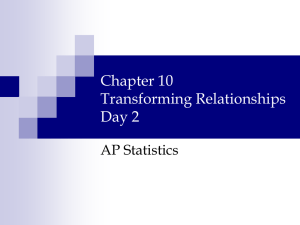Part 3 - Creative control
advertisement
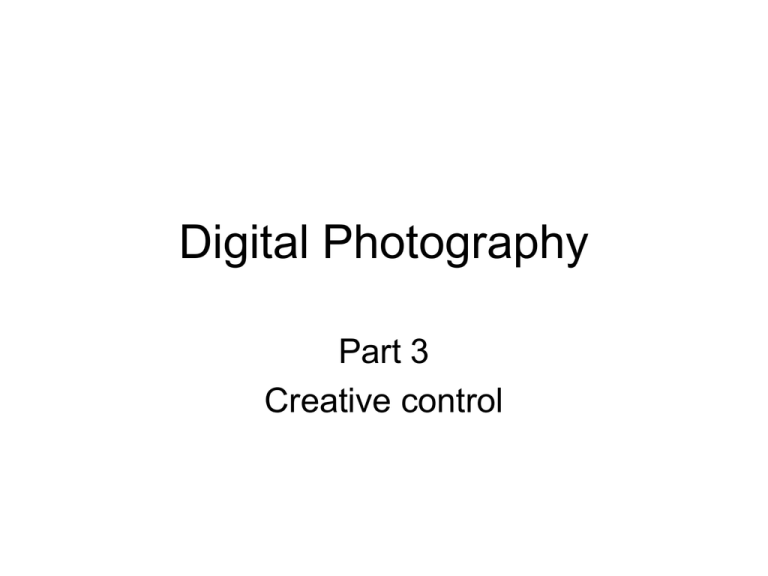
Digital Photography Part 3 Creative control What are creative controls? The key factors that decide how a composition will look: • focusing • white balance • shutter speed • aperture • focal length Cameras can set these automatically (except focal length), but learning how to use them manually helps in getting great pictures. Péter Tarján 2 Shutter speed Shutter speed is one of the 2 factors that determine exposure. Shutter speed is the time interval during which the shutter is open and the sensor is getting light. For every full stop, the amount of light on the sensor is (about) doubled/halved. Reasons to set shutter speed manually: • avoid camera shake • freeze movement • blur movement • panning • increase/reduce depth of field The standard shutter speeds: … 4 sec 2 sec 1 sec 1/2 sec 1/4 sec 1/8 sec 1/15 sec Péter Tarján 1/30 sec 1/60 sec 1/125 sec 1/250 sec 1/500 sec 1/1000 sec 1/2000 sec … 3 Effect of shutter speed Péter Tarján 4 Steady shooting When shutter speed is low, camera shake may blur the image. Its effect can be greatly reduced by holding the camera correctly. Hold the camera firmly with both hands. Stand with your feet slightly apart. Hold your elbows close to your body. Squeeze the shutter button gently. Get additional support from knees, walls, ledges… Experiment what works for you. More good tips here: http://knol.google.com/k/vesna-kozelj/how-to-holdthe-camera-with-your-hands/3k0expg5xjecw/2# Péter Tarján 5 Freezing movement For freezing movement, you need a fast shutter speed. But how fast? It depends on how fast the subject is moving across the frame – not the actual speed! Distance to the subject also counts. Subjects moving towards or away from the camera need slower shutter speed than those moving across the frame. Also: for close subjects, you can use a flash – it almost always freezes the movement. Subject Speed Distance efl across Direction of motion toward diagonal car 80 km/h 30 m 100 mm 1/1000 sec 1/250 sec 1/500 sec train 160 km/h 50 m 35 mm 1/500 sec 1/125 sec 1/250 sec jogger 10 km/h 5m 100 mm 1/750 sec 1/180 sec 1/300 sec jet plane 800 km/h 2000 m 400 mm 1/500 sec 1/125 sec 1/250 sec Péter Tarján 6 Effect of freezing movement Péter Tarján 7 Blurred movement Fast shutter speeds sometimes fail to Panning: tracking a subject with the convey the dynamism of a moving camera, using slow shutter speed, causing the subject to remain sharp and background subject: a speeding car may look to blur. Technique: just like a parked one. Choosing a • hold the camera steady with two hands slow shutter speed blurs the • swing your shoulders from your waist, movement, which may work without moving your feet better. Shutter speed shouldn’t be • leave more space in front of the moving just slighly slow (blur without the subject than behind artistic effect) or too slow (image • follow the subject across and press the may be unrecognizable). Rule of shutter button smoothly thumb: 4 stops slower shutter than • take lots of shots to get a few that work what you would use for freezing the action. Péter Tarján 8 Blurring Péter Tarján 9 Extended exposures In low light, exposures of more than 1 second may be needed. Some tips: • Support the camera. • If the camera is supported, you are free to choose any shutter speed. Choose shutter speed/aperture to suit your needs. • Choose the lowest ISO setting to minimize noise. • Use self-timer/shutter release cable/remote control to fire the camera. • Avoid the widest aperture settings to maximize image quality. • If you can’t get a slow enough shutter speed, use a neutral density filter. • Low-light shots tend to be overexposed by the camera; correct for that or use manual exposure. Camera supports • whatever you find • beanbag • unipod (monopod) • tripod (pan-tilt head, ball-and-socket head) head (with camera platform and quickhandle release shoe) crank center column Péter Tarján telescopic legs 10 Effect of extended exposures Péter Tarján 11 Depth of field In principle only objects at a given distance from the lens are sharp – everything closer or further away are blurred to varying degrees. The blur is invisible for a given range of distances around the focusing distance, so everything within that range looks sharp. This range is called the Depth of Field (DoF). Depth of Field depends on a number of factors. Péter Tarján Factors determining DoF: • aperture: the smaller the aperture (higher f-stops), the more the DoF. • focusing distance (subject distance): the farther away the focus is, the more the DoF. • focal length (zoom setting): the shorter the focal length (=wide angle) the more the DoF. • “circle of confusion”: how big a circle you are willing accept as “point”. Subjective! It also depends on image magnification and how closely it is viewed. 12 Depth of field: aperture effect 7.4 mm focal length (35 mm efl), focus on red die Péter Tarján 13 Depth of field: focal length effect focus on red die, f/4.0 Péter Tarján 14 Depth of field: focusing distance effect efl 65 mm, f/3.2 Péter Tarján 15 Depth of field: size matters Is the yellow die sharp? It depends on the magnification and your definition of “sharp”. Péter Tarján 16 Maximizing depth Use the controls together to maximize DoF: use wide lens/zoom setting, close the aperture, get further away from the foreground elements. Multipoint autofocus helps. The through-the-lens (TTL) viewfinder of bridge and SLR cameras may give an idea of DoF. Péter Tarján 17 Minimizing depth Throwing things out of focus is usually much more difficult on digital cameras – SLRs rule here. The main things you can do: • use long telephoto • use wide aperture • get close to subject Why? Keeping parts of the picture blurred can help concentrate on the main subject and can result in more powerful pictures. Péter Tarján 18 focus DoF<1 cm! More DoF tips Bokeh: out-of-focus background with smoothly blurred highlights when taking pictures of people or animals, always focus on the eyes! We tend to look at them first and blur is the most annoying when in the eyes DoF in close-up photography is extremely narrow – fight it or use it to your advantage Péter Tarján 19 Aperture and lens resolution In several picture-taking situation, more than one shutter speedaperture combination yields a shake-free picture and enough DoF. In that case, you can take one other factor into consideration: lens resolution. Lenses provide their best resolution at their mid-apertures. Wider settings decrease resolvable detail because lenses work better optically near their center than their edges. At small apertures, diffraction on the edges of the aperture itself causes another drop in image quality. Quality decrease due to diffraction is worse for smaller sensors. Thus, SLRs can use narrower apertures (typically f/22) before diffraction becomes significant than zoom compacts (typically f/8) or bridge cameras (f/11). Bottom line: use a mid-aperture setting whenever you can. Péter Tarján 20 Focal length Changing the focal length of the lens by zooming changes the angle of view of the camera. This is a very important compositional tool: • useful for cropping when taking the picture • allows you to maximize sensor effectiveness • changing it together with the subject distance, it gives more flexibility in choosing background • allows you to take very different types of shots. Péter Tarján 21 Perspective same perspective! Perspective is the optical effect that makes distant objects appear smaller than close ones and parallel lines seem to converge. It gives vital clues about depth in the picture. Perspective depends only on the distance! But using different focal lengths can change the picture because telephoto lenses are used from further away – and that changes perspective. Péter Tarján different perspective 22 Manipulating the background Whether using wideangle or telephoto lenses, you can end up with very similarlooking pictures. What can change dramatically when you change focal length (and subject distance) is what is in the background and how it looks (DoF, perspective…). Péter Tarján 23 Wide-angle lenses Wide-angle lenses offer a wider field of view than our eyes. Uses: • fit a lot of things into the frame • exaggerate foreground • create a wide DoF Problem: barrel distortion Péter Tarján 24 Telephoto lenses Telephoto lenses offer a narrower field of view than our eyes. Uses: • bring distant objects “closer” • “compress” distances between objects • create a narrow DoF Problem: heavy, magnifies camera shake Péter Tarján 25
